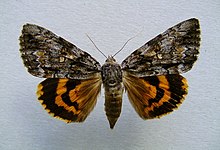Catocala palaeogama
| Catocala palaeogama | ||||||||||||
|---|---|---|---|---|---|---|---|---|---|---|---|---|

Catocala palaeogama in camouflage |
||||||||||||
| Systematics | ||||||||||||
|
||||||||||||
| Scientific name | ||||||||||||
| Catocala palaeogama | ||||||||||||
| Guenée , 1852 |
Catocala palaeogama is a butterfly ( moth )found in North Americafromthe owl butterfly family (Noctuidae).
features
butterfly
The moths reach a wingspan of 60 to 70 millimeters. The basic color of the forewing upper side shows various gray or brown tones as well as a strong marbling. Ring and kidney defects are usually indistinct. Only the sub-kidney flaws stand out a little brighter. The middle area between the wavy line and the outer transverse line is lightly reddish brown, a root welt is colored strongly black. the upper side of the hind wing varies from yellow to yellow-orange and shows a broad black band as well as a black, wavy central band. The fringes are checked in black and yellow. The undersides of the wings show a black-brown / yellow banding.
Caterpillar
Adult caterpillars are reddish gray in color and drawn with some thin dark lines, stripes and dots. They show brownish thickenings behind the eighth body segment. The two foremost and the two rearmost body segments are colored black-brown. The light gray head capsule is drawn with many red-brown longitudinal lines.
Similar species
In the Catocala neogama , which is similar in drawing , the black root welt is stronger, in Catocala subnata less developed.
distribution and habitat
Catocala palaeogama is common to local in the eastern and some central regions of North America. The species primarily inhabits deciduous forests.
Way of life
The nocturnal, univoltine moths can be found between June and October, mainly in August. You visit artificial light sources and baits . During the day, they prefer to rest on tree trunks, on which they are well camouflaged due to their color and the folded wings over their abdomen and thus hardly recognizable to predators. The eggs are deposited under the bark of the food trees where they overwinter. The caterpillars hatch in spring and feed primarily on the leaves of hickory species ( Carya ) and other walnut plants ( Juglandaceae ).
Individual evidence
Web links
- mothphotographersgroup - Sites listed by Mississippi State University
- funet.fi - dissemination

